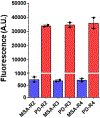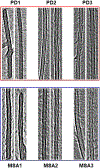Discriminating α-synuclein strains in Parkinson's disease and multiple system atrophy
- PMID: 32025029
- PMCID: PMC7066875
- DOI: 10.1038/s41586-020-1984-7
Discriminating α-synuclein strains in Parkinson's disease and multiple system atrophy
Abstract
Synucleinopathies are neurodegenerative diseases that are associated with the misfolding and aggregation of α-synuclein, including Parkinson's disease, dementia with Lewy bodies and multiple system atrophy1. Clinically, it is challenging to differentiate Parkinson's disease and multiple system atrophy, especially at the early stages of disease2. Aggregates of α-synuclein in distinct synucleinopathies have been proposed to represent different conformational strains of α-synuclein that can self-propagate and spread from cell to cell3-6. Protein misfolding cyclic amplification (PMCA) is a technique that has previously been used to detect α-synuclein aggregates in samples of cerebrospinal fluid with high sensitivity and specificity7,8. Here we show that the α-synuclein-PMCA assay can discriminate between samples of cerebrospinal fluid from patients diagnosed with Parkinson's disease and samples from patients with multiple system atrophy, with an overall sensitivity of 95.4%. We used a combination of biochemical, biophysical and biological methods to analyse the product of α-synuclein-PMCA, and found that the characteristics of the α-synuclein aggregates in the cerebrospinal fluid could be used to readily distinguish between Parkinson's disease and multiple system atrophy. We also found that the properties of aggregates that were amplified from the cerebrospinal fluid were similar to those of aggregates that were amplified from the brain. These findings suggest that α-synuclein aggregates that are associated with Parkinson's disease and multiple system atrophy correspond to different conformational strains of α-synuclein, which can be amplified and detected by α-synuclein-PMCA. Our results may help to improve our understanding of the mechanism of α-synuclein misfolding and the structures of the aggregates that are implicated in different synucleinopathies, and may also enable the development of a biochemical assay to discriminate between Parkinson's disease and multiple system atrophy.
Conflict of interest statement
Figures












Comment in
-
Neurodegenerative diseases distinguished through protein-structure analysis.Nature. 2020 Feb;578(7794):223-224. doi: 10.1038/d41586-020-00131-3. Nature. 2020. PMID: 32042086 No abstract available.
-
Commentary: Discriminating α-synuclein strains in parkinson's disease and multiple system atrophy.Front Neurosci. 2020 Aug 25;14:802. doi: 10.3389/fnins.2020.00802. eCollection 2020. Front Neurosci. 2020. PMID: 32982662 Free PMC article. No abstract available.
-
RT-QUiC in multiple system atrophy: the biomarker of the future? and other updates on recent autonomic research.Clin Auton Res. 2021 Feb;31(1):47-49. doi: 10.1007/s10286-021-00767-9. Epub 2021 Jan 29. Clin Auton Res. 2021. PMID: 33515140 No abstract available.
References
MeSH terms
Substances
Grants and funding
LinkOut - more resources
Full Text Sources
Other Literature Sources
Medical

